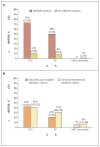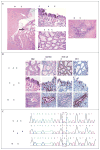ARID1A mutations in endometriosis-associated ovarian carcinomas
- PMID: 20942669
- PMCID: PMC2976679
- DOI: 10.1056/NEJMoa1008433
ARID1A mutations in endometriosis-associated ovarian carcinomas
Abstract
Background: Ovarian clear-cell and endometrioid carcinomas may arise from endometriosis, but the molecular events involved in this transformation have not been described.
Methods: We sequenced the whole transcriptomes of 18 ovarian clear-cell carcinomas and 1 ovarian clear-cell carcinoma cell line and found somatic mutations in ARID1A (the AT-rich interactive domain 1A [SWI-like] gene) in 6 of the samples. ARID1A encodes BAF250a, a key component of the SWI–SNF chromatin remodeling complex. We sequenced ARID1A in an additional 210 ovarian carcinomas and a second ovarian clear-cell carcinoma cell line and measured BAF250a expression by means of immunohistochemical analysis in an additional 455 ovarian carcinomas.
Results: ARID1A mutations were seen in 55 of 119 ovarian clear-cell carcinomas (46%), 10 of 33 endometrioid carcinomas (30%), and none of the 76 high-grade serous ovarian carcinomas. Seventeen carcinomas had two somatic mutations each. Loss of the BAF250a protein correlated strongly with the ovarian clear-cell carcinoma and endometrioid carcinoma subtypes and the presence of ARID1A mutations. In two patients, ARID1A mutations and loss of BAF250a expression were evident in the tumor and contiguous atypical endometriosis but not in distant endometriotic lesions.
Conclusions: These data implicate ARID1A as a tumor-suppressor gene frequently disrupted in ovarian clear-cell and endometrioid carcinomas. Since ARID1A mutation and loss of BAF250a can be seen in the preneoplastic lesions, we speculate that this is an early event in the transformation of endometriosis into cancer. (Funded by the British Columbia Cancer Foundation and the Vancouver General Hospital–University of British Columbia Hospital Foundation.).
Figures



Comment in
-
The origin of ovarian cancer—is it getting clearer?N Engl J Med. 2010 Oct 14;363(16):1574-5. doi: 10.1056/NEJMe1009527. N Engl J Med. 2010. PMID: 20942676 No abstract available.
-
Endometriosis-associated ovarian carcinomas.N Engl J Med. 2011 Feb 3;364(5):483-4; author reply 484-5. doi: 10.1056/NEJMc1012780. N Engl J Med. 2011. PMID: 21288104 No abstract available.
-
Endometriosis-associated ovarian carcinomas.N Engl J Med. 2011 Feb 3;364(5):482-3; author reply 484-5. doi: 10.1056/NEJMc1012780. N Engl J Med. 2011. PMID: 21288105 No abstract available.
References
-
- Jemal A, Siegel R, Xu J, Ward E. Cancer Statistics, 2010. CA Cancer J Clin. 2010 July 7; (Epub ahead of print) - PubMed
-
- Köbel M, Kalloger SE, Huntsman DG, et al. Differences in tumor type in low-stage versus high-stage ovarian carcinomas. Int J Gynecol Pathol. 2010;29:203–11. - PubMed
-
- Tavassoli FA, Devilee P, editors. World Health Organization of classification of tumours. Vol. 4. Lyon, France: IARC Press; 2003. Pathology and genetics of tumours of the breast and female genital organs.
Publication types
MeSH terms
Substances
Grants and funding
LinkOut - more resources
Full Text Sources
Other Literature Sources
Medical
Molecular Biology Databases
